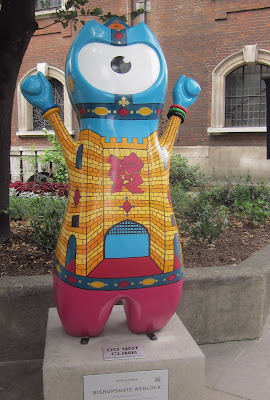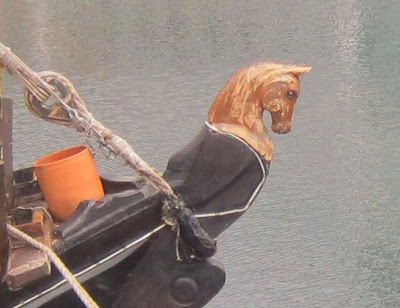KILLHOPE. Not an encouraging name, but I suspect anyone working there in the late 19th century would have felt it was appropriate.
I've been in Co. Durham, a county I've always longed to explore. Last week we took S. up there and one of the places we went was an old lead mine way out in the countryside. You can borrow wellies, a hard hat and a torch and go inside the mine... so we did.
If you look hard you can see the date "1851" below. It was carved by one of a small group of men who had spent a backbreaking year .....
 cutting a narrow, uncomfortable tunnel by hand into the side of the hill.for perhaps seventy yards.
cutting a narrow, uncomfortable tunnel by hand into the side of the hill.for perhaps seventy yards.
 cutting a narrow, uncomfortable tunnel by hand into the side of the hill.for perhaps seventy yards.
cutting a narrow, uncomfortable tunnel by hand into the side of the hill.for perhaps seventy yards.  Here's the entrance to the tunnel where miners dragged wagons of lead ore over the rails. It's necessary to wade through a fast flowing channel of peaty brown water which is several inches deep throughout the mine.
Here's the entrance to the tunnel where miners dragged wagons of lead ore over the rails. It's necessary to wade through a fast flowing channel of peaty brown water which is several inches deep throughout the mine. So in we went. It was a warm enough day, but the temperature dropped as we splashed into the darkness, daylight fading behind. I decided to take photos without flash, to catch the atmosphere. The view below looks back to the entrance, past the dim figure of T with his lamp. I know it's just a trick of the light but it was a bit spooky, as if there was a luminous white figure following us... can you see it? You can see the water rippling beneath our feet too.
The mining was done mostly by candle light, and as it got darker, we turned off our lamps and the flickering candle flame took over.

S., aged 10, was interested t learn that children of his age would have worked at the mine, though they'd have been outside, raking the ore, rather than braving the conditions within.
Lead mines are not deep. The faces are vertical, exposed sometimes by the use of explosives. So in the filthy, dusty atmosphere, the miners had to work upwards, hacking out the lead ore and allowing it to crash to the ground, after which it would be collected and heaved into wagons.
It must have been desperately hard work. I didn't know what "heavy as lead" meant till I picked up a chunk of ore. I'm not weak but it was almost too much for me.

The ore has a bright silvery hue, (and does contain some silver) which gives a bit of a "Seven Dwarves" feel - it almost could be treasure, glittering away.
 The lead miners suffered terribly, and their health was ruined by the work. Always up to their shins in cold water, they developed chronic foot rot, and were always cold. They could not get out of the mine even for lunch or to go to the toilet. A "thunderbox" was carried in and out each day, and set down in the swirling water for them to use.
The lead miners suffered terribly, and their health was ruined by the work. Always up to their shins in cold water, they developed chronic foot rot, and were always cold. They could not get out of the mine even for lunch or to go to the toilet. A "thunderbox" was carried in and out each day, and set down in the swirling water for them to use. The dusty atmosphere and lack of sunlight affected their lungs, and many died of tuberculosis. After a day of hard toil, they slept together in miserable dormitories on site, and many a man must have been kept awake by the coughing of his mates all night. They were paid a pittance, half-yearly.
There's a giant underground waterwheel in the centre of the mine, impossible to photograph but working incessantly in the dark - the wood is always soaking wet, and I don't know why it doesn't rot as it splashes inexorably round and round.
There's a giant underground waterwheel in the centre of the mine, impossible to photograph but working incessantly in the dark - the wood is always soaking wet, and I don't know why it doesn't rot as it splashes inexorably round and round.
We spent a few minutes in pitch darkness by the water-wheel, listening to its relentless swishing and thinking of one miner who was trapped for three days in the wheel chamber. He drank the water and ate his tallow candles to keep alive.
Yes, it really could be a bit spooky down there, although I have always had a bit of an imagination. I began to think there were ghostly men tapping above my head, a figure with arms upraised ....

S. was more interested in making scary faces with his torch. This one is the most sinister - he was pleased with it.

It was quite a relief to reach the entrance again...and get out. As I admired the evening sunshine lighting up the trees by the river, I could only feel sadness for the men who spent their lives undergound.

So if you're in or near Co. Durham, I recommend a visit to Killhope. Click here for the website. The centre has a fascinating museum of impressive mineral specimens and traditional needlework and crafts. It also has a collection of spar boxes,

which are almost impossible to photograph (at least, they are for me). These weird bits of Victoriana are tableaux made of minerals and crystals, sometimes incorporating taxidermy. A few, like the one above, were very large and were exhibited on a cart, for money. Others were just created for fun. Many use mirrors and lights (originally candlelight) to create a fairy-tale atmosphere. Below, there's a garden of crystals and mirrors reflecting the beautifully detailed dolls' houses into infinity but I am afraid my photo really doesn't catch the atmosphere.
The centre also has some very accomplished work by local craftsmen in the shop, it runs all kinds of interesting courses and it's very eco-friendly. It even has a hand-made yurt conference centre and you can't get much more ecological than that.
Best of all the volunteers are charming, and one of them even gave S. a bag of minerals so he could build his very own spar cabinet. He's now looking for a little glass fronted box and possibly a little train to run through his stony landscape.
I'll try and post more about Durham soon - it really is cool. First, though, I have to write my article, and rather quickly too. Gulp.











































